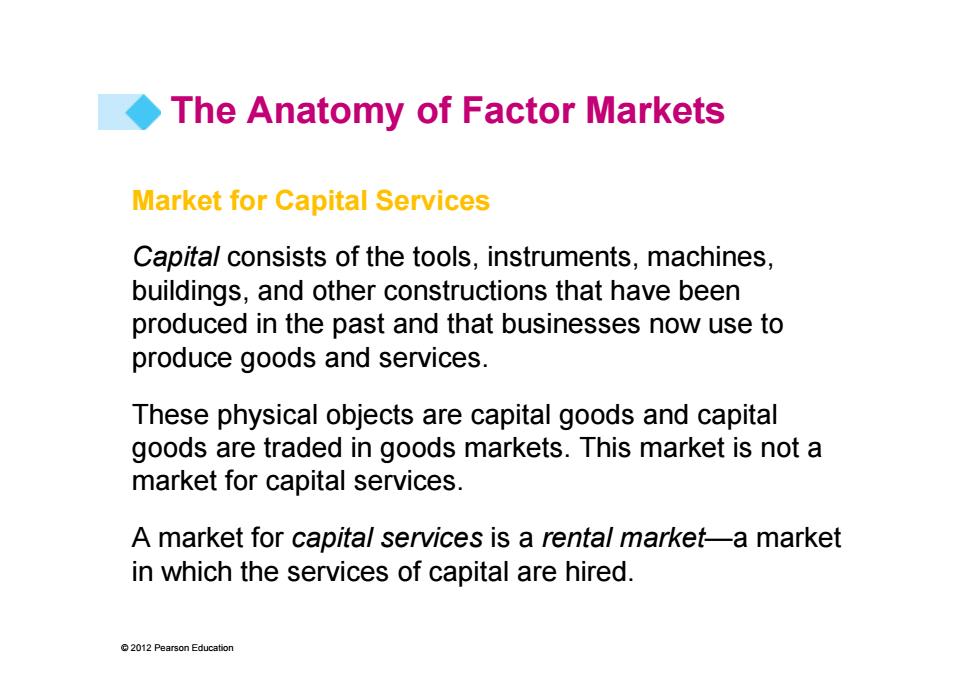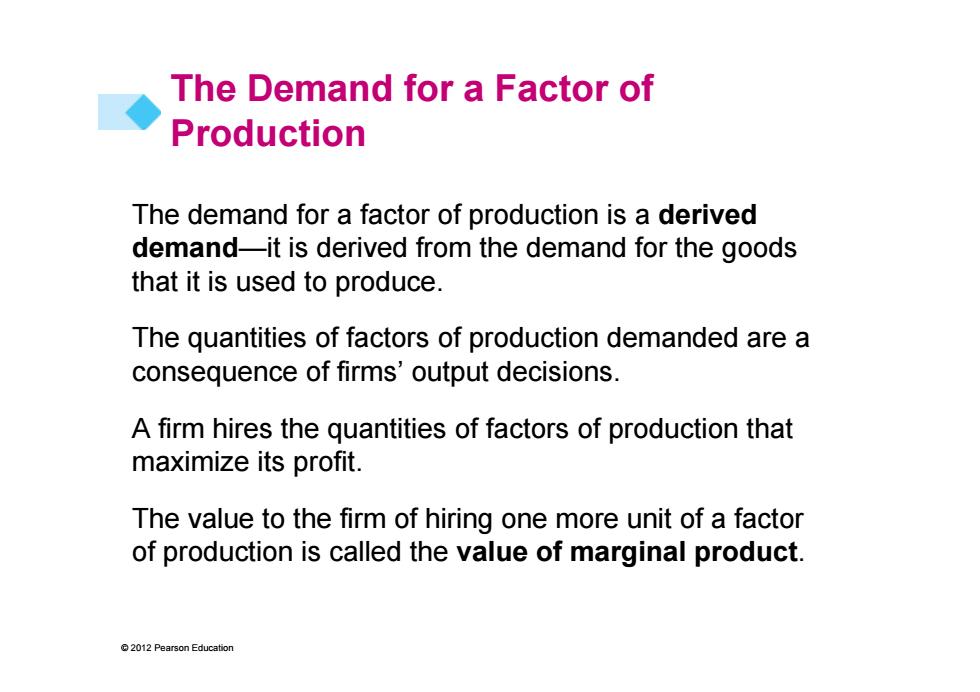
MARKETS FOR CH.8 FACTORS OF PRODUCTION
CH.8 MARKETS FOR FACTORS OF PRODUCTION

The Anatomy of Factor Markets Four factors of production are Labor Capital Land (natural resources) Entrepreneurship Let's take a look at the markets in which these factors of production are traded. 2012 Pearson Education
© 2012 Pearson Education The Anatomy of Factor Markets Four factors of production are Labor Capital Land (natural resources) Entrepreneurship Let’s take a look at the markets in which these factors of production are traded

The Anatomy of Factor Markets Market for Labor Services Labor services are the physical and mental work effort that people supply to produce goods and services. A labor market is a collection of people and firms who trade labor services. The price of labor services is the wage rate. Most labor markets have many buyers and many sellers and are competitive.In these labor markets,the wage rate is determined by supply and demand. 2012 Pearson Education
© 2012 Pearson Education Market for Labor Services Labor services are the physical and mental work effort that people supply to produce goods and services. A labor market is a collection of people and firms who trade labor services. The price of labor services is the wage rate. Most labor markets have many buyers and many sellers and are competitive. In these labor markets, the wage rate is determined by supply and demand. The Anatomy of Factor Markets

The Anatomy of Factor Markets Market for Capital Services Capita/consists of the tools,instruments,machines, buildings,and other constructions that have been produced in the past and that businesses now use to produce goods and services. These physical objects are capital goods and capital goods are traded in goods markets.This market is not a market for capital services. A market for capital services is a rental market-a market in which the services of capital are hired. 2012 Pearson Education
© 2012 Pearson Education Market for Capital Services Capital consists of the tools, instruments, machines, buildings, and other constructions that have been produced in the past and that businesses now use to produce goods and services. These physical objects are capital goods and capital goods are traded in goods markets. This market is not a market for capital services. A market for capital services is a rental market—a market in which the services of capital are hired. The Anatomy of Factor Markets

The Anatomy of Factor Markets Markets for Land Services and Natural Resources Land consists of all the gifts of nature-natural resources. The market for land as a factor of production is the market for the services of land-the use of land. The price of the services of land is a rental rate. Nonrenewable natural resources are resources that can be used only once,such as oil,natural gas,and coal. The prices of nonrenewable natural resources are determined in global commodity markets. 2012 Pearson Education
© 2012 Pearson Education Markets for Land Services and Natural Resources Land consists of all the gifts of nature—natural resources. The market for land as a factor of production is the market for the services of land—the use of land. The price of the services of land is a rental rate. Nonrenewable natural resources are resources that can be used only once, such as oil, natural gas, and coal. The prices of nonrenewable natural resources are determined in global commodity markets. The Anatomy of Factor Markets

The Anatomy of Factor Markets Entrepreneurship Entrepreneurship services are not traded in markets. Entrepreneurs receive the profit or bear the loss that results from their business decisions. 2012 Pearson Education
© 2012 Pearson Education Entrepreneurship Entrepreneurship services are not traded in markets. Entrepreneurs receive the profit or bear the loss that results from their business decisions. The Anatomy of Factor Markets

The Demand for a Factor of Production The demand for a factor of production is a derived demand-it is derived from the demand for the goods that it is used to produce. The quantities of factors of production demanded are a consequence of firms'output decisions. A firm hires the quantities of factors of production that maximize its profit. The value to the firm of hiring one more unit of a factor of production is called the value of marginal product. 2012 Pearson Education
© 2012 Pearson Education The demand for a factor of production is a derived demand—it is derived from the demand for the goods that it is used to produce. The quantities of factors of production demanded are a consequence of firms’ output decisions. A firm hires the quantities of factors of production that maximize its profit. The value to the firm of hiring one more unit of a factor of production is called the value of marginal product. The Demand for a Factor of Production

The Demand for a Factor of Production Value of Marginal Product The value to the firm of hiring one more unit of a factor is called its value of marginal product. Value of marginal product of a factor Price of a unit of output X Marginal product of the factor 2012 Pearson Education
© 2012 Pearson Education Value of Marginal Product The value to the firm of hiring one more unit of a factor is called its value of marginal product. Value of marginal product of a factor = Price of a unit of output × Marginal product of the factor The Demand for a Factor of Production

The Demand for a Factor of Production Table 18.1 shows the calculation of VMP. From the firm's total product schedule,calculate the marginal product of labor. -TABLE 18.1 Value of Marginal Product at Angelo's Bakery Quantity Total Marginal of labor product product ) (TP) (workers) (loaves per hour) A 0 0 1 2 13 …5 0 18 …4 22 +3 5 25 2012 Pearson Education
© 2012 Pearson Education Table 18.1 shows the calculation of VMP. From the firm’s total product schedule, calculate the marginal product of labor. The Demand for a Factor of Production

TABLE 18.1 Value of Marginal Product at Angelo's Bakery Value of Quantity Total Marginal marginal of labor product product product ) (TP) MP=△TP/△L) (VMP=MP×P) (workers) (loaves per hour) (loaves per worker) (dollars per worker) A 0 0 7 14 B 7 12 2 13 …5 10 D 3 18 4 E 22 6 5 25 2012 Pearson Education
© 2012 Pearson Education